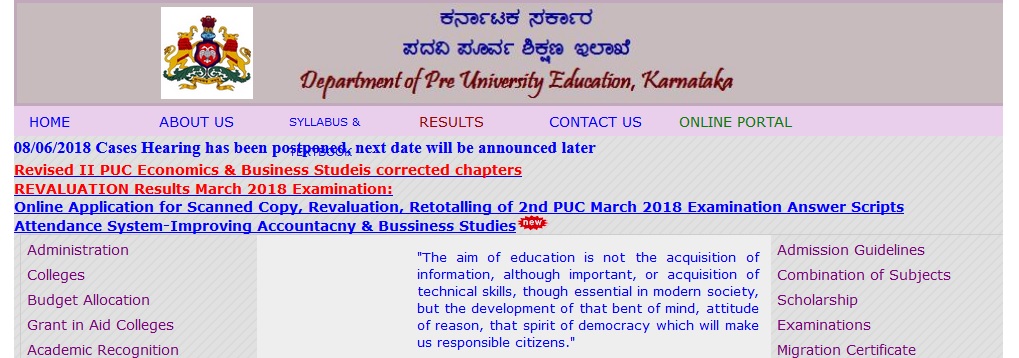www.pue.kar.nic.in Chemistry II Model Question Paper : Karnataka PUC/ Pre University
Organization : Karnataka Department of Pre-University Education
Exam : II PU Chemistry
Document type : Question Paper
Website : pue.kar.nic.in
Download Previous/ Old Question Papers :
April 2006 : https://www.pdfquestion.in/uploads/pue.kar.nic.in/5963-a0634.pdf
July 2006 : https://www.pdfquestion.in/uploads/pue.kar.nic.in/5963-j0634.pdf
April 2007 : https://www.pdfquestion.in/uploads/pue.kar.nic.in/5963-a0734.pdf
July 2007 : https://www.pdfquestion.in/uploads/pue.kar.nic.in/5963-j0734.pdf
March 2008 : https://www.pdfquestion.in/uploads/pue.kar.nic.in/5963-j0834.pdf
June 2008 : https://www.pdfquestion.in/uploads/pue.kar.nic.in/5963-j0834.pdf
March 2009 : https://www.pdfquestion.in/uploads/pue.kar.nic.in/5963-m0934.pdf
July 2009 : https://www.pdfquestion.in/uploads/pue.kar.nic.in/5963-j0934.pdf
March 2010 : https://www.pdfquestion.in/uploads/pue.kar.nic.in/5963-m1034.pdf
July 2010 : https://www.pdfquestion.in/uploads/pue.kar.nic.in/5963-j1034.pdf
March 2011 : https://www.pdfquestion.in/uploads/pue.kar.nic.in/5963-m1134.pdf
July 2011 : https://www.pdfquestion.in/uploads/pue.kar.nic.in/5963-j1134.pdf
March 2014 :https://www.pdfquestion.in/uploads/pue.kar.nic.in/5963-m1434.pdf
PUE Chemistry Question Paper
New Scheme ( For Students studied during the Year 2005-2006 )
Related : PUC Model Question Paper Mathematics II Karnataka : www.pdfquestion.in/5964.html
March / April, 2006
( New Syllabus ) Time : 3 Hours ] [ Max. Marks : 90
Instructions : i) The question paper has four Parts.
ii) Parts A, B, C and D are common to all the candidates.
iii) Part A carries 10 marks, Each question carries one mark.
PART – A
Note : i) Answer all the 10 questions.
ii) Questions have to be answered in one word or in one
1. Out of carbon and zinc which is a stronger reducing agent –
2. Why is Fe 3 + ion more stable than Fe 2 + ion –
3. If the rate of the reaction is independent of concentration of the reactant,
what is the order of the reaction –
4. Which noble gas is not adsorbed by charcoal –
5. What is hydronium ion –
6. What is the only factor on which the colligative property value depends –
7. Between potassium nitrate and aluminium nitrate which one is required in
8. Which is the organic product obtained when methyl magnesium iodide
9. Name the least stable cycloalkane.
10. How many amino acid units are present in insulin –

PART – B
Note : i) Answer any ten questions.
ii) Each question carries two marks. 10 × 2 = 20
11. Justify that concentrated sulphuric acid is a good dehydrating agent with
12. Calculate the bond order in oxygen molecule.
13. The time for half-life of a first order reaction is found to be 30 mins. What
14. Define Faraday’s first law of electrolysis.
15. What is a spontaneous reaction – Explain with an example.
16. What is Tyndall effect – Explain.
17. Calculate the number of particles present in the unit cell of BCC.
18. Distinguish between inductive effect and electromeric effect.
i) — CH 3 group ii) — NO 2 group.
20. How is ethanamine prepared from ethane nitrile –
PART – C
I. Answer any two of the following : 2 × 5 = 10
23. a) How are noble gases separated by Dewar’s charcoal adsorption
b) With the help of the Ellingham’s diagram, explain why silver
24. a) Give the postulates of Werner’s theory of coordination
b) Copper (I) compounds are white and diamagnetic whereas
25. a) Describe the manufacture of sodium hydroxide using
II. Answer any three of the following :
26. a) Discuss the molecular orbital structure of benzene. 3
b) Explain geometrical isomerism with an example. 2
27. a) What is S N 1 mechanism – Explain it using hydrolysis t-butyl
b) Give any two uses of aniline. 2
28. a) Write the Howarth’s ring structure for ß-D ( – ) fructopyranose.
b) Define the term ‘iodine value of an oil’. Mention its significance.
c) What is isoelectric point of amino acids – 1
29. a) Write the equations for the following reactions : 4
March / April, 2007
Part – A :
1. Name the process used for desilverisation of lead.
2. During electrolysis of brine H + ions get discharged in preference to sodium ions. Give the reason.
3. Give an example of a complex where a ligand satisfies both the primary and secondary valencies of the metal ion.
4. Define Threshold energy.
5. What is the pH of 10 – 2 M NaOH ?
6. What happens to the vapour pressure of a liquid when a non-volatile solute is dissolved in it ?
7. Name the final product formed when a primary amine is subjected to alkylation.
8. Write the general equation for Wurtz reaction.
9. Give the structural formula of pyrogallol.
10. What is meant by denaturation of a protein ?
Part – B :
11. With the help of Ellingham diagram explain why Aluminium is used as a reducing agent in the manufacture of chromium from chromic oxide.
12. How does conc. sulphuric acid react with oxalic acid crystals ? Give equation.
13. Calculate EAN of iron in potassium ferrocyanide.
14. Sketch the shape of sigma bonding and antibonding molecular orbitals when s-atomic orbitals overlap.
15. Show that the rate of a first order reaction doubles when the concentration of the reactant is doubled.
16. Explain why NH 3 molecule can be considered both as a Lewis base and a Br˙o˙ nsted base.
17. Calculate the number of particles present in the unit cell of BCC.
18. Give any two differences between an ideal solution and a non-ideal solution.
19. How do you convert chloroethane to ethanoic acid ? Give equations.
20. What is Sache-Mohr theory of strainless rings ?
21. How is a primary amine prepared by Hofmann’s bromamide reaction ?
22. Write the Haworth’s structure of α-maltose.
Need maths and physics question papers with answers